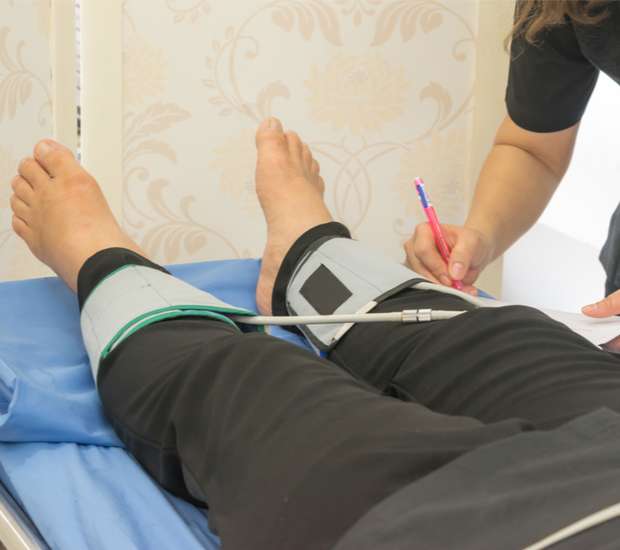Peripheral Arterial DiseaseBronx, NY
If you are experiencing leg pain when walking and cannot seem to determine the cause, the pain may be the result of issues with the body's blood flow. Peripheral arterial disease is a health condition that can cause claudication, also known as pain, when walking. Peripheral arterial disease, PAD, reduces blood flow to the extremities caused by narrowed arteries.
Peripheral arterial disease treatment is available at KezMed Medical PC in Bronx and the surrounding area. Under the direction of Dr. Kezerashvili, MD FACC, we can treat the underlying conditions and help the individual manage symptoms. The goal of treatment is to reduce pain, restore mobility, and the ability to walk, while also preventing complications such as heart attack and stroke.
Reach us at 646-216-1270 to make an appointment to start managing the symptoms of peripheral arterial disease.
Signs and Symptoms
People with varying levels of peripheral arterial disease do not display easy-to-notice symptoms. The most common sign of this condition is experiencing pain while walking. This cramping pain is known as claudication and ranges from mild to severe. Some individuals also experience:
- Lack of a pulse in the feet or legs
- Shiny or discolored skin on the lower legs
- Slow leg hair growth
- Wounds on the legs and feet that will not heal
- A numb, cold, or tingling feeling in the legs
- Erectile dysfunction in men
- Pain in the legs while lying down, usually when the disease progresses
Risk Factors and Underlying Causes
Atherosclerosis is the most common cause of peripheral arterial disease. With this condition, cholesterol intake leads to the accumulation of fat deposits in the blood vessels. This increase in fat deposits in the blood vessels limits circulation to the legs and other parts of the body, causing symptoms.
Patients who have a family history of a stroke, heart attack, or peripheral arterial disease are also at risk of the condition. Having high blood pressure, high cholesterol, or diabetes can also increase the risk of this condition. Even lifestyle choices and habits can increase the risk of peripheral arterial disease.
People who smoke can increase the risk of this condition, as well. Other lifestyle choices, such as being obese or being over the age of 50, can also increase risk. Thus, we recommend seeking professional treatment to prevent the symptoms from getting worse.
Treatment and Preventive Measures
People who experience the symptoms described above should seek medical care right away. If left untreated, the peripheral arterial disease can cause heart attack and stroke. In advanced cases, sores that cannot heal become infected and may lead to amputation. Common treatments for peripheral arterial disease include:
- Medications to control high blood pressure and high cholesterol
- Daily aspirin therapy or another medication to reduce the risk for blood clots that can cause a heart attack or stroke
- Medications to improve circulation
- Glucose control measures for individuals who have diabetes
- Angioplasty, a surgery in which a blocked artery is reopened to reduce claudication
- Bypass surgery, in which a graft artery is used to reroute blood around a blocked artery
- Thrombolytic treatment to break up an existing blood clot
Preventive lifestyle changes are the recommended way to lower the risk for peripheral arterial disease and stay healthy after treatment for this condition. These measures include quitting smoking, blood sugar management for those with diabetes, lowering cholesterol, lowering blood pressure, losing weight, maintaining a healthy weight, and exercising.
Individuals who are concerned about their risk for peripheral arterial disease or experiencing symptoms should have a screening to maintain circulatory health and mobility. Call us at 646-216-1270 to make an appointment today.
Frequently Asked Questions
Should I be screened for peripheral arterial disease?
Possibly. We may recommend screening for peripheral arterial disease in patients after they reach the age of 65. If you smoke or have diabetes or a family history of diabetes, you should begin screening at age 50. We may recommend screening at a younger age for those who have diabetes along with another risk factor like high blood pressure or obesity.
How is peripheral arterial disease diagnosed?
Some signs of this condition, like weak pulses, are evident during a physical exam. The doctor may also compare the blood pressures of the arm and the leg (ankle-brachial index) and take a blood test to measure cholesterol levels. Imaging tests such as angiography and ultrasound are used to visualize narrowed arteries.
Why is foot care important for those with peripheral arterial disease?
Poor circulation means that even minor cuts, blisters, and injuries can become severely infected. Those diagnosed with this condition should check the feet for injuries each day and see a doctor even for seemingly small concerns. Always wear thick, cushioned socks and shoes that fit comfortably and correctly.
Why does peripheral arterial disease often go undiagnosed?
Because many people do not experience symptoms, they might not see a doctor until the pain becomes severe. Often, these individuals have other health concerns that take precedence. Sometimes, the signs of peripheral artery disease are mistaken for those of a different medical condition.


![Harmful Lifestyle Habits For Your Heart [Ask A Cardiologist]](../../wp-content/uploads/Cardiologist-220.jpg)



